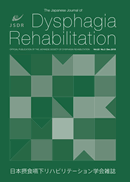Volume 10, Issue 1
The Japanese Journal of Dysphagia Rehabilitation
Displaying 1-8 of 8 articles from this issue
- |<
- <
- 1
- >
- >|
Review Article
-
2006Volume 10Issue 1 Pages 3-11
Published: April 30, 2006
Released on J-STAGE: December 26, 2020
Download PDF (4482K)
Original Paper
-
2006Volume 10Issue 1 Pages 12-21
Published: April 30, 2006
Released on J-STAGE: December 26, 2020
Download PDF (4240K) -
2006Volume 10Issue 1 Pages 22-30
Published: April 30, 2006
Released on J-STAGE: December 26, 2020
Download PDF (4097K) -
2006Volume 10Issue 1 Pages 31-42
Published: April 30, 2006
Released on J-STAGE: December 26, 2020
Download PDF (5167K) -
2006Volume 10Issue 1 Pages 43-51
Published: April 30, 2006
Released on J-STAGE: December 26, 2020
Download PDF (3815K) -
2006Volume 10Issue 1 Pages 52-61
Published: April 30, 2006
Released on J-STAGE: December 26, 2020
Download PDF (4371K) -
2006Volume 10Issue 1 Pages 62-71
Published: April 30, 2006
Released on J-STAGE: December 26, 2020
Download PDF (3980K)
Clinical Report
-
2006Volume 10Issue 1 Pages 72-76
Published: April 30, 2006
Released on J-STAGE: December 26, 2020
Download PDF (2251K)
- |<
- <
- 1
- >
- >|
